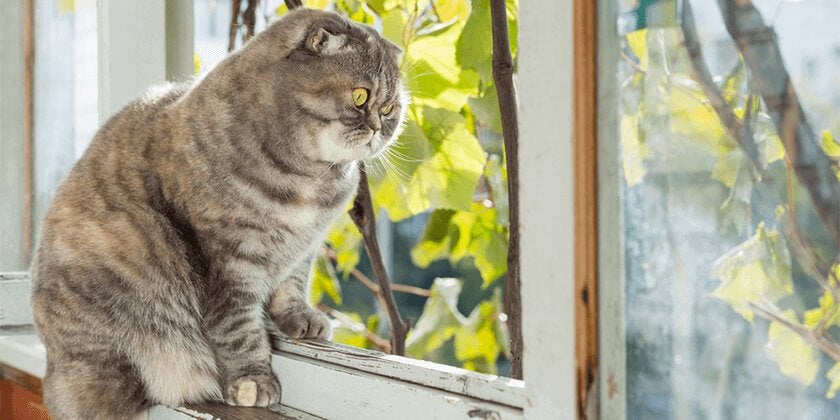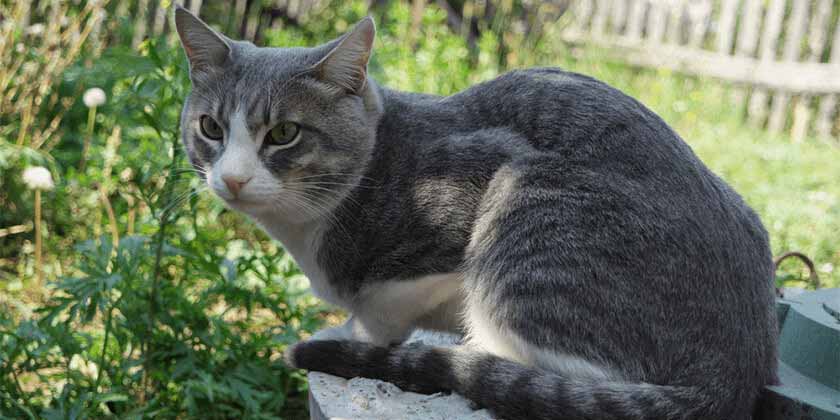How to protect your cat

Cats are naturally inquisitive creatures that enjoy exploring the house and the neighbourhood. However as a pet owner, you’re probably well aware that the human and natural worlds hold potential dangers for your feline family member. From indoor hazards to outdoor threats, these are the most common risks to be aware of and the steps you can take to reduce your cat’s exposure to injury, disease, and other risks.
Indoor hazards
Poisons
Everyday household items can be poisonous to cats, so keep these common items locked away and well out of reach if you have them around the house, garage or garden shed, and clean up any spilled substances immediately so that your cat can’t get to it.
- Car products – This includes antifreeze, petrol, windscreen washer fluid, and brake fluid.
- Beauty items – Hair dye, sunscreen, nail polish, and deodorants can be poisonous to cats.
- Human medication – Common medications such as aspirin and paracetamol are highly toxic for cats.
- Decorating and household products – These include turpentine or methylated spirits, bleach, disinfectants, laundry detergent, paint, varnish and mothballs.
- Pest control items – Pest control items to keep away from your cat include fungicides, insecticides, herbicides, snail bait and rodent control products.
- Human food – Cats can be poisoned if they eat certain human foods, including raisins, grapes, chocolate, avocado, alcohol, coffee, macadamia nuts, mushrooms and onions. Also, never give your cat cooked bones because they can splinter and cause internal injury.
- Dog medication – Dog flea treatment and other medications for dogs can be highly toxic to cats.
Remember, your cat can ingest poisonous substances in a number of ways. They can be poisoned by directly ingesting the item or by ingesting it through contaminated food or prey, through grooming contaminated fur, through skin absorption, and by inhaling the substance. If you think your cat has ingested a poisonous substance, don’t delay – seek veterinary attention immediately.
Falls
Cats are also at risk from falls, especially if they’re an indoor cat or you live in a high-rise apartment. Unless your windows are always kept shut, you’ll want to ensure that all windows are screened with strong wire mesh. Check your window meshing on a regular basis for any damage, as cats can slip through small holes.
Make sure that access to any balconies is blocked. Some owners think their cats are reasonably well trained and won’t be tempted to jump from open windows or balcony railings, but cats can be distracted if they’re focused on a bird or other prey and jump without realising the danger.

Appliances and spaces
Cats love small, confined spaces, and they’ll often crawl into gaps and other areas when they want to have a quiet nap. Sometimes this can be dangerous, especially when it’s on the inside of an appliance such as a washing machine or tumble dryer. Other places to keep your cat away from include chimneys and fireplaces, paper shredders, and fridges.
Cats have even been known to be attracted to hotplates and the water in toilets, so keep these covered and out of reach of your kitty when not in use.
Toys and other indoor dangers
Other indoor dangers to watch out for include electric cables, sewing needles and accessories, and toys that your cat might be tempted to chew and swallow. Some cats are attracted to festive decorations with colourful designs and interesting shapes, so keep these stored and lock away if possible.
Protecting your cat outdoors
Like most cats, your feline friend will probably enjoy spending some time outdoors. Before you let them outside, it’s a good idea have your cat microchipped so they’re easily identifiable if they do get lost. In fact, microchipping is required by law in many states and territories.
Indoor versus outdoor cats
Some owners prefer keeping their cats indoors all the time; others believe it’s okay for their cat to roam without an enclosure. If you decide to let your kitty be an outdoor cat, always make sure it is well adjusted to the neighbourhood and that they can find their way home.
Note that letting your cat out to roam comes with its own risks, including injury through traffic accidents, fights with other pets, and poisoning from garden chemicals. There’s also the risk of catching an infectious disease and exposure to parasites, getting lost, and the added stress of knowing your cat is roaming outside.
However, outdoor cats can experience a number of benefits. They can have more social contact and exercise. For cats, going out can satisfy a basic behavioural need, so your cat might be less likely to become bored or frustrated. You can reduce the risks associated with outdoor-roaming cats by bringing them indoors at night and at peak-hour periods.
Cats that go outside should wear a clearly labelled, colourful collar with a safety catch that comes undone if they get caught in shrubbery. Follow a recommended vaccination and deworming program. If your cat isn’t neutered, consider getting it done because neutered cats are less likely to wander far and are also less likely to fight with other cats.
If you don’t want your cat to roam freely outside, consider cat-proofing your garden walls. You will probably need to install special fencing to make sure your cat cannot scale your fence or climb the trees in your garden that could allow them to escape the boundary.

Garden threats
There are many common plants in the garden that are toxic to cats or could lead to skin issues. Some cats like to nibble on plants, and some cats have been poisoned just from brushing past a plant and later ingesting the pollen when grooming.
If you have indoor plants or cut flowers, these could also pose a risk to your cat. Lilies, foxglove, Lily of the Valley, ferns, ivy and holly are just some of the plants5 that can irritate or poison your cat. Always check labels and review the plants in your garden before letting your cat out.
Cats are not strong swimmers, so secure your pool with a good cover if you have an outdoor cat. Water features such as garden ponds and fountains – especially those filled with colourful ornamental fish – can also be magnets for curious cats, so it’s a good idea to keep these covered with wire meshing to keep your cat out of the water.
Exposure to the elements
Even outdoor cats accustomed to staying outside can suffer from exposure to the elements, especially during weather extremes. Provide easy access to your house with a pet door and ensure that your cat always has plenty of water to drink. Set up cool and shady areas in your garden so your cat can have a break from the sun when it’s too hot.
Cats have been known to get into sheds and greenhouses, so always check before you lock these up to ensure your cat isn’t locked in and unable to access water.
7 Jun 2016